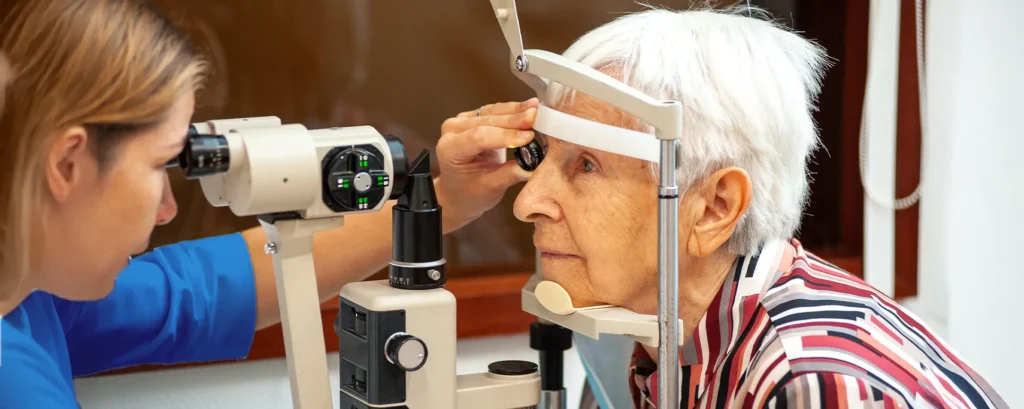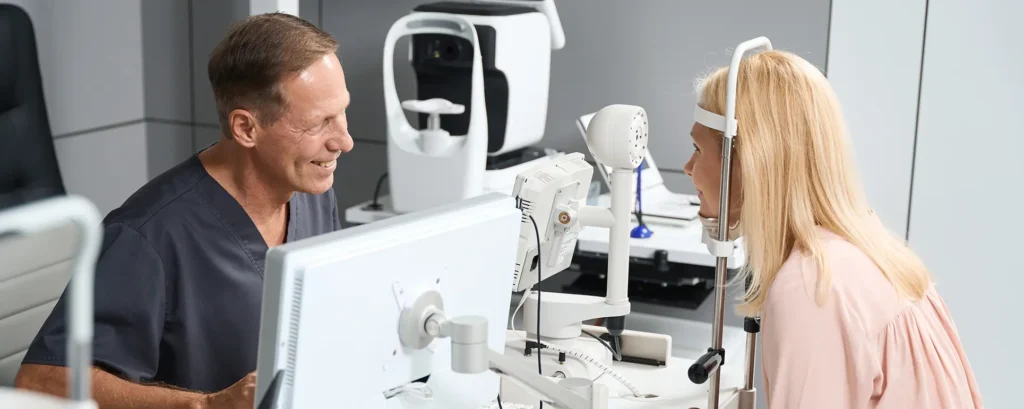1. Cataracts are the leading cause of blindness worldwide
Globally, cataracts account for about 45% of all cases of blindness, according to the World Health Organization. This means that nearly 20 million people are blind due to cataracts, even though surgery could restore their sight in most cases.
In low- and middle-income countries, cataracts are responsible for up to 60% of blindness, reflecting the lack of access to affordable eye care. By comparison, in the UK, cataract-related blindness is rare because surgery is widely available through the NHS.
The numbers underline a global inequality: while cataract surgery is routine in Britain, millions around the world still lose their vision from a condition that is highly treatable.
2. More than 30% of people over 65 in the UK have cataracts
In the UK, about one in three adults over the age of 65 are living with cataracts that are visible on examination. That’s more than 3.5 million people, given the current size of the UK’s older population.
Not all of these individuals need surgery right away, but the prevalence shows how common cataracts become with age. Many are first detected during routine eye tests, sometimes before patients even notice any symptoms.
This statistic shows that cataracts aren’t unusual or exceptional — they are part of the normal ageing process for a large share of the population.
3. By age 75, over 50% of people have cataracts

Once people reach their mid-70s, cataracts are more likely than not. More than half of adults aged 75 and above have cataracts affecting their vision, and the figure rises to nearly 70% among those aged 85 and older.
That means the majority of people in their late 70s will need cataract surgery at some point. In fact, in the UK, more than half of all cataract operations are performed on people over the age of 75.
This statistic makes clear that if you live long enough, cataracts are almost inevitable — which is why surgery has become one of the most common medical procedures in the country.
4. Cataract surgery is the most common operation performed in the NHS
Every year, the NHS performs around 450,000 cataract operations, making it the single most common surgical procedure. That means nearly 1,200 operations every day, on average.
The sheer volume reflects both the prevalence of cataracts and the efficiency of modern surgical techniques. In some hospitals, surgical teams perform more than 20 cataract operations per theatre session, showing how streamlined the process has become.
This level of activity also ensures surgeons have extensive experience. The high numbers translate directly into strong outcomes, since repetition and routine make the operation one of the safest in medicine.
5. Private cataract surgery waiting times are weeks, not months

On the NHS, the average waiting time for cataract surgery is around 16–20 weeks, and in some regions patients wait longer than six months. By contrast, private clinics in the UK typically offer surgery within 2–6 weeks, with urgent cases seen even sooner.
This difference is significant for patients whose daily lives are disrupted by poor vision. For instance, those unable to drive because of cataracts may struggle with independence for months while waiting for NHS treatment.
The numbers highlight a gap between public and private systems: both provide excellent surgery, but one often delivers it far more quickly.
6. Over 95% of people have improved vision after cataract surgery
Cataract surgery has one of the highest success rates of any operation. More than 95% of patients report improved vision afterwards, and in many studies the figure is as high as 98%.
For context, around 9 out of 10 people achieve at least 6/12 vision (the standard for driving) following surgery, even without glasses. This makes it one of the most reliable operations in terms of restoring practical sight.
These numbers explain why patient satisfaction with cataract surgery consistently exceeds 90% — most people see a real and lasting benefit almost immediately.
7. Less than 2% of cataract surgeries result in serious complications
Major complications such as endophthalmitis (infection inside the eye) or retinal detachment occur in fewer than 2% of cases, with most UK studies placing the rate closer to 1.5%.
Minor issues, such as temporary rises in eye pressure or corneal swelling, happen in about 5–7% of cases, but are usually treatable and rarely cause long-term harm.
This extremely low risk profile is one of the main reasons cataract surgery is trusted worldwide. Out of hundreds of thousands of operations each year, only a small fraction lead to lasting problems.
8. Posterior capsule opacification affects up to 20% of patients within 5 years
Posterior capsule opacification (PCO) is the most common long-term complication of cataract surgery. Around 15–20% of patients develop it within 5 years, and by 10 years the figure can rise to 30%.
In England alone, more than 80,000 YAG laser capsulotomies — the procedure to fix PCO — are performed annually. It’s a simple outpatient treatment that takes just a few minutes.
This shows that while cataract surgery has an excellent success rate, follow-up treatment is common. Fortunately, the numbers demonstrate that PCO is easy to manage and rarely a cause for lasting concern.
9. Cataracts account for more than 10 million operations worldwide every year
Globally, over 10 million cataract surgeries take place each year, and some estimates suggest the figure is closer to 15 million when all regions are included.
This makes it not only the most common eye operation but one of the most common surgeries of any type. For comparison, hip replacements number around 2 million worldwide annually, showing how cataract surgery dwarfs many other procedures.
The numbers highlight the scale of the condition: cataracts affect people everywhere, and surgery is the single biggest intervention in global eye health.
10. The average NHS cataract surgery waiting time is over 16 weeks in some regions
Across England, the median waiting time for cataract surgery is around 14–16 weeks, but in certain regions patients wait much longer. In some areas of Wales and Northern Ireland, waits of 20–30 weeks are not unusual.
This creates a postcode lottery where access to surgery depends heavily on where you live. In London, for example, average waits are typically shorter than in rural areas, where fewer hospitals offer eye surgery.
The numbers show why some patients choose private care: when the difference is several months, the impact on day-to-day living can be substantial.
11. Diabetes doubles the risk of cataracts

People with diabetes are 2 to 2.5 times more likely to develop cataracts than those without the condition. Among people under 65, about 20% of diabetics already have cataracts, compared to 10% of non-diabetics.
High blood sugar accelerates changes in the lens, leading to earlier and faster cataract development. Diabetics are also more likely to need surgery at a younger age — often 10 years earlier than their non-diabetic peers.
This makes regular eye checks essential for the UK’s 4.3 million people with diabetes, since cataracts are both common and treatable when caught early.
12. Smoking increases cataract risk by up to 60%
Smokers face a 60% higher risk of developing cataracts than non-smokers, and heavy smokers have up to three times the risk.
Studies estimate that smoking accounts for about 20% of cataract cases worldwide, making it one of the leading preventable risk factors. Quitting smoking not only lowers the risk but also improves overall eye health.
The numbers are a clear message: avoiding or giving up smoking can delay the onset of cataracts and may reduce the likelihood of needing surgery.
13. Women are more likely to develop cataracts than men
Globally, women account for about 60% of all cataract cases, even though they represent just over half of the population. This means women are disproportionately affected.
In the UK, women are slightly more likely to undergo cataract surgery than men, largely because they live longer. On average, women in Britain live about 4 years longer than men, giving cataracts more time to develop.
In countries with limited access to care, women are also less likely to receive surgery than men, creating a gender gap in both prevalence and treatment.
14. UV exposure is a major risk factor for cataracts
Long-term exposure to ultraviolet (UV) light significantly increases the risk of cataracts. Studies suggest that people with high lifetime sun exposure are 25–30% more likely to develop cataracts.
Outdoor workers, such as farmers and builders, are particularly affected. In some studies, they show cataract onset 5–10 years earlier than people with mostly indoor occupations.
Wearing UV-blocking sunglasses reduces the risk considerably. In fact, research shows that proper UV protection can lower the chance of developing cataracts by around 20%.
15. Cataract surgery costs between £2,500 and £4,000 privately in the UK
For private patients, cataract surgery typically costs between £2,500 and £4,000 per eye in the UK. The price varies depending on the clinic, the surgeon’s expertise, and the type of intraocular lens chosen.
Premium lenses such as multifocals or torics often push the cost to the higher end of that range. Some London clinics charge over £4,500 per eye for the latest technology lenses.
These figures show why private surgery is a major financial decision. However, for those struggling with long NHS waits, the investment can feel worthwhile for the speed and choice it offers.
16. Around 30% of cataract patients choose premium lenses privately
When offered a choice, about 30% of UK private cataract patients opt for premium intraocular lenses, such as multifocal or toric designs. These lenses can reduce or even eliminate the need for glasses after surgery.
Premium lens uptake is highest in urban centres like London, where more clinics provide advanced options. In some private hospitals, the figure is closer to 40%, showing strong demand among patients who want spectacle independence.
The numbers illustrate a growing trend: patients increasingly see cataract surgery not only as a medical necessity but also as a chance to upgrade their vision for long-term convenience.
17. Cataracts are developing earlier in life for some groups
In the past, cataracts were most often diagnosed in people in their 70s and 80s. However, recent research suggests that more people in their 50s and early 60s are now being affected. In the UK, around 10% of people aged 55–64 already show clinically significant cataracts, compared with only 5% in the same age group two decades ago.
Lifestyle and health conditions are believed to be driving this trend. Rates of diabetes, obesity, and long-term corticosteroid use have risen in recent years, and each of these factors accelerates cataract development. For example, people with poorly controlled diabetes can develop cataracts up to 10 years earlier than non-diabetic peers.
The numbers are a reminder that cataracts are not only linked with old age. If you’re in your 50s and notice your vision getting cloudy, you’re not alone — a growing share of younger patients are now undergoing surgery, and the trend looks set to continue.
18. More than 90% of cataract patients would recommend the surgery
Cataract surgery consistently ranks as one of the most satisfying medical procedures. Surveys show that over 92% of patients say their quality of life improves afterwards, and more than 9 out of 10 would recommend the operation to friends or family. This satisfaction is much higher than for many other common surgeries.
The benefits show up quickly. In one UK survey, 87% of patients reported noticeable improvements within a week, and by one month, over 95% were satisfied with their vision. Many describe colours as appearing brighter and sharper almost immediately after surgery.
Numbers like these explain why cataract surgery has such a strong reputation. It’s not only safe and effective but also transformative, restoring independence and confidence for the vast majority of people who have it.
19. Cataract surgery reduces the risk of falls in older adults
Falls are one of the biggest health risks for older people, with around 30% of over-65s in the UK experiencing at least one fall each year. Vision problems caused by cataracts make falls much more likely. Studies show that cataract surgery can significantly reduce this risk.
One large study found that first-eye cataract surgery reduced falls by 34%, and having both eyes treated reduced them by 53%. This makes surgery not just a vision-restoring procedure but also a proven way to improve safety in older age.
Given that falls account for around 250,000 hospital admissions every year in England, the role of cataract surgery in prevention is substantial. For patients, it means that clearer vision doesn’t just improve day-to-day life — it may also help keep them out of hospital.
20. By 2050, the number of people with cataracts worldwide is expected to double
At present, it’s estimated that around 95 million people worldwide are living with cataracts that significantly affect their vision. By 2050, this figure is projected to reach nearly 190 million, driven by longer life expectancies and ageing populations across every continent.
The scale of this increase is striking. In Europe alone, cataract cases are expected to rise by 60% between 2020 and 2050, while in Asia the numbers are predicted to nearly double. This will place huge demand on health systems, especially in countries where access to surgery is already limited.
For patients, this statistic is both a warning and a reassurance. Cataracts will remain almost inevitable with age, but the global focus on eye health means that surgery is likely to become even more widely available. Planning for this doubling is already under way in many countries, ensuring future generations have access to treatment.
References with Links
- Cataracts as a leading cause of global blindness
World Health Organization (WHO). Blindness and vision impairment.
https://www.who.int/news-room/fact-sheets/detail/blindness-and-visual-impairment - Global burden of cataract visual impairment (94 million affected, 20 million blind)
Flaxman SR, et al. Global causes of blindness and distance vision impairment 1990–2020: a systematic review and meta-analysis. Lancet Global Health.
https://pmc.ncbi.nlm.nih.gov/articles/PMC6005639/ - NHS cataract surgery volume (~450,000 per year)
NHS England. Cataract surgery activity data.
https://www.england.nhs.uk/statistics/statistical-work-areas/hospital-admitted-patient-care-activity/ - NHS cataract surgery waiting times (16+ weeks in some regions)
NHS England. Referral to treatment (RTT) waiting times data.
https://www.england.nhs.uk/statistics/statistical-work-areas/rtt-waiting-times/ - Private cataract surgery costs (£2,500–£4,000 per eye)
London Cataract Centre. Cataract surgery cost UK.
https://www.londoncataractcentre.co.uk/cataract-surgery-cost.html - Posterior capsule opacification prevalence (15–20% within 5 years)
Awasthi N, Guo S, Wagner BJ. Posterior capsule opacification: a problem reduced but not yet eradicated. Arch Ophthalmol.
https://jamanetwork.com/journals/jamaophthalmology/fullarticle/2653383 - Diabetes doubles cataract risk
West SK, Valmadrid CT. Epidemiology of risk factors for age-related cataract. Surv Ophthalmol.
https://pubmed.ncbi.nlm.nih.gov/10733120/ - Smoking increases cataract risk (up to 60%)
Ye J, He J, Wang C, et al. Smoking and risk of age-related cataract: a meta-analysis. Invest Ophthalmol Vis Sci.
https://pubmed.ncbi.nlm.nih.gov/22198728/ - Falls reduced by cataract surgery (34–53%)
Harwood RH, Foss AJ, Osborn F, et al. Falls and health status in elderly women following first eye cataract surgery: a randomised controlled trial. Br J Ophthalmol.
https://bjo.bmj.com/content/89/1/53 - Future prevalence doubling by 2050 (~190 million cases)
Brien Holden Vision Institute. Global Vision Database projections.
https://iovs.arvojournals.org/article.aspx?articleid=2560069

